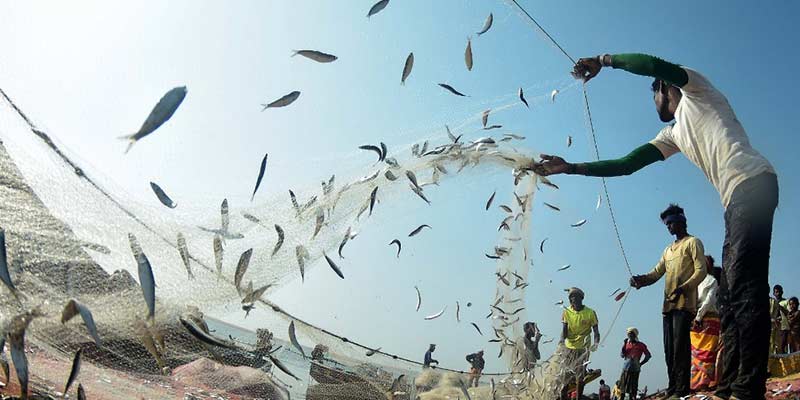- India
- Mar 18
Explainer / Blue Revolution in India
The government plans to bring out a National Fisheries Policy for holistic development of the sector which is growing at an annual rate of 8 per cent, Union Fisheries Minister Giriraj Singh said in the Rajya Sabha.
The government will take care of the interest of traditional fishermen while framing the policy, Singh said while replying to supplementary questions during Question Hour.
The policy would focus on bringing new technology and ways to deal with threats from cyclones as part of the overall objective to improve fishermen’s income, Singh said.
The proposed policy would incorporate the provisions of the existing National Policy on Marine Fisheries 2017. It would have provisions for the sub-sectors of inland fisheries, aquaculture and mariculture, including elements of post-harvest.
“Given the cross-cutting nature of various fisheries sub-sectors, it is considered that an integrated National Fisheries Policy would better serve the public interest rather than individual sub-sector wise policies,” Singh said.
The minister said allocation of funds to boost the sector would depend on sectoral needs and priorities.
Blue Revolution
Fisheries and aquaculture production contributes around 1 per cent to India’s gross domestic product (GDP) and over 5 per cent to the agricultural GDP.
India, one of the major fish producing nations in the world, stands second in aquaculture production in the world.
The Ministry of Fisheries, Animal Husbandry and Dairying is implementing various schemes / programmes for the development of the fisheries sector with a view towards enhancement of fish production.
Since 2015-16, the department of fisheries has been implementing a centrally sponsored scheme (CSS) on Blue Revolution: Integrated Development and Management of Fisheries with a total central outlay of Rs 3,000 crore for the development of fisheries. The CSS is being implemented in all states and Union Territories to supplement their efforts by providing financial assistance.
The Blue Revolution is being implemented to achieve economic prosperity of fishermen and fish farmers and to contribute towards food and nutritional security through optimum utilisation of water resources for fisheries development in a sustainable manner, keeping in view the bio-security and environmental concerns.
Singh highlighted that the government has allocated Rs 560 crore for continuation of Blue Revolution scheme during 2020-21 fiscal for undertaking various ongoing fisheries development programmes.
The CSS provides financial assistance for the development of fisheries and aquaculture sector including fish production and post harvest related activities like fish brood banks, hatcheries, construction of ponds, rearing ponds, installation of cages in reservoirs and open sea cages fish culture, fish feed mills, development of post-harvest infrastructure like ice plants, cold storages, ice plants-cum-cold storages and development of fish landing centre in reservoirs and fishing harbours.
The Indian Council of Agricultural Research (ICAR) has eight fisheries research institutes and 33 research centres.
Other major schemes
A Fisheries and Aquaculture Infrastructure Fund (FIDF) has been implemented with a fund size of Rs 7,522.48 crore spread over a period of five years.
The fund provides finance at concessional rates to states and its entities, including private sector, for development of fisheries infrastructure facilities in marine and inland fisheries sectors.
Under the FIDF, the ministry provides interest subvention up to 3 per cent per annum for providing the concessional finance by the Nodal Loaning Entities for development of infrastructure in the fisheries sector.
In 2018-19, the government extended the facility of Kisan Credit Card to fish farmers to help them to meet their working capital needs.
In Union Budget for 2019-20, the government announced a new scheme called Pradhan Mantri Matsya Sampada Yojana (PMMSY) for the sector.
The ministry has formulated the PMSSY scheme, which envisages a total investment of about Rs 20,050 crore, which includes central, states and beneficiary shares over a period of five years, with effect from 2020-21.
NavIC messaging system
India’s own regional navigation satellite system named as Navigation with Indian Constellation (NavIC) was established by ISRO and has been functional since April 2018.
The Indian National Centre for Ocean Information System (INCOIS) is using the NavIC messaging system to broadcast emergency warning messages like cyclone, tsunami and high waves as and when it occurs and also for broadcasting of information of Potential Fishing Zone (PFZ).
The fisheries department of various coastal states have been made aware of this technology for the fishermen community. ISRO has distributed about 250 units each to the State Fisheries Department of Kerala and Tamil Nadu for the use of fishermen.
Manorama Yearbook app is now available on Google Play Store and iOS App Store

